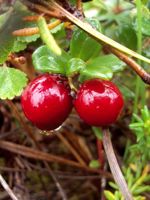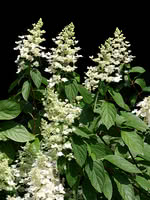Mon-Fri 9am - 5pm Mountain time
Phantom Hydrangea vs Small Cranberry
Vaccinium oxycoccos
Hydrangea paniculata Phantom
CUSTOM GROW
CUSTOM GROW
Small Cranberry is a native evergreen groundcover found in bogs, fens, and wet meadows. It produces delicate pink flowers that attract a variety of pollinators, including bees, and it serves as both a nectar source and host plant for the Bog Fritillary (Boloria eunomia) butterfly. By late summer, the plant bears deep red berries that are eaten by both wildlife and people. With their high pectin content, the berries are well-suited for making jams and jellies.
Often creeping among sphagnum moss, Small Cranberry thrives in cold, acidic, and nutrient-poor soils (pH 2.9–4.7), making it well adapted to northern wetland environments. With its woody stems, it is technically classified as a shrub and often described as a subshrub or dwarf shrub. It is also valuable for wetland restoration and naturalisation projects.
Note: We use Small Cranberry for Vaccinium oxycoccos. This species is also known by many other common names, including Bog Cranberry, Small Bog Cranberry, and others. Please confirm the scientific name to ensure you are ordering the correct plant.
Phantom Hydrangea is a striking deciduous shrub with impressive blooms. It is multi-stemmed and produces pale green flowers that fade to white and soft pink as they mature. These flower clusters can reach up to 15” (40cm) long and while other shrubs will droop from the flowers' weight, Phantom Hydrangea has sturdy stems that support them.
This adaptable shrub will make a beautiful addition to your yard as a flowering hedge or as an ornamental plant on its own. Try pruning the flowers after they are spent to get even larger flower heads.

